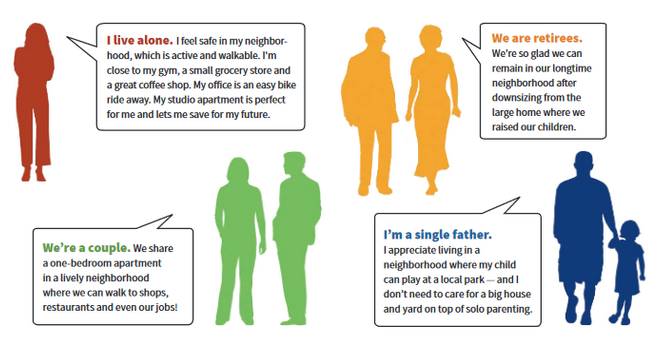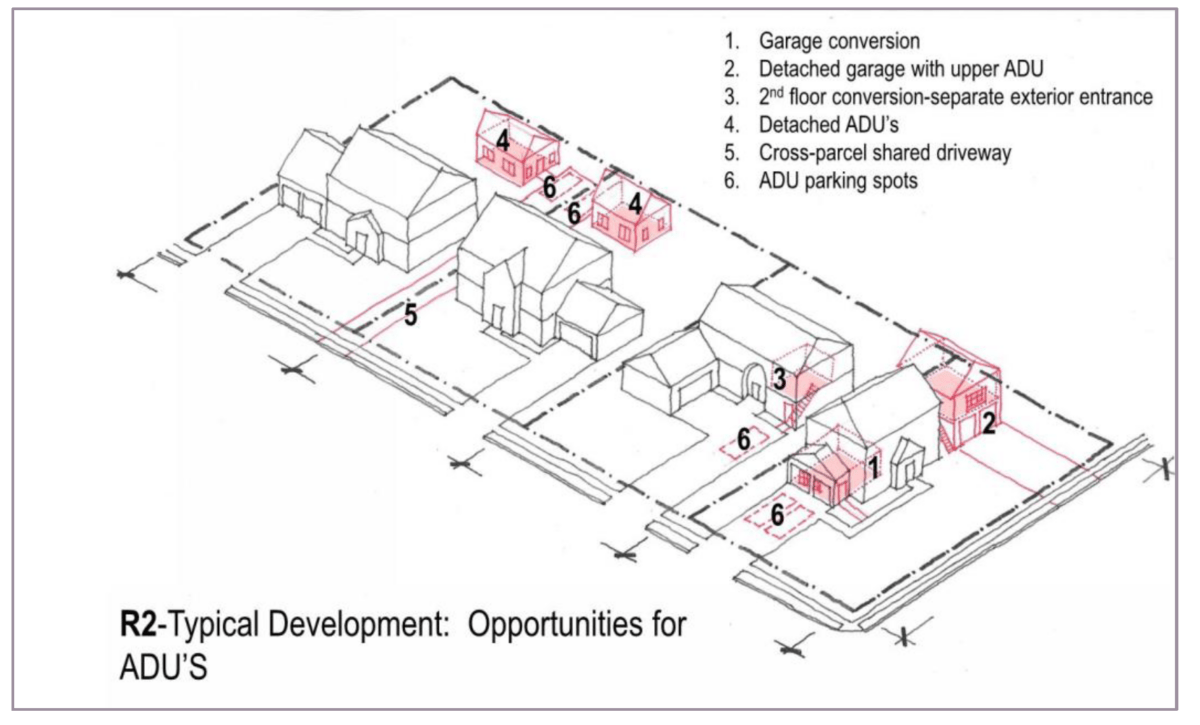On Wednesday (May 24), the Chapel Hill Town Council will open a public hearing to consider a proposal to allow people to build duplexes and small homes throughout our community, not just in a handful of neighborhoods. We’re excited about this proposal because we think it will be a small but significant step towards making Chapel Hill into a community where people from all backgrounds can thrive.
In emails to council, posts on NextDoor and Facebook, columns in Chapelboro, and at the public hearing in January, we’ve heard the same myths, half-truths, and outright falsehoods repeated over and over again. It’s safe to say that some of the usual suspects will again be trotting out some of the usual arguments during the public hearing on Wednesday.
Given the barrage of fear-based commentary that we expect they’ll be hearing on Wednesday, here are a few things that we hope the mayor and members of Town Council keep in mind while they’re sitting on the dais listening to public comment, and afterwards as they are deciding how to vote on the housing choices proposal.
1. The likely outcome of the Housing Choices policy will be a slow increase in density in existing residential neighborhoods, not a spate of tear-downs
Chapel Hill is not the first community to attempt to update to its zoning code to allow for more housing options throughout the entire town. Minneapolis and Raleigh have done the same. And as Town staff demonstrated several months ago, the pace of change in both of those cities has been modest. Our local opponents to the proposal have claimed that the ordinance changes will unleash a flurry of teardowns and radical change to our neighborhoods. That’s clearly not true. The pace of change will be slow, and gradual, as town staff pointed out in their original presentation.

It’s important to keep in mind that many of the homes in Chapel Hill are aging. Older and smaller homes that have fallen behind on maintenance, with critical structural flaws, or that do not meet the needs of modern families (such as having more than one bathroom) are at risk to be torn down, regardless of what the Town chooses to do with the housing choices proposal.
And the number of homes that are teardowns candidates will only increase over time. If the only thing that can be built to replace smaller single-family homes are larger single-family homes, that’s what will be built, and our neighborhoods will become increasingly exclusive and expensive. Allowing the construction of duplexes and (in limited neighborhoods) triplexes and quadplexes will allow the town’s housing stock to diversify over time, providing more options that are less expensive than a single home on a single lot.
Also, context is important. Multiple emails have come from residents of Tenney Circle, a neighborhood right near downtown. According to Zillow, each of the homes along Tenney Circle would sell for more than $1 million, and some for more than $2 million. One is valued at more than $5 million. Multiple homes have in-ground swimming pools. Investors are not chomping at the bit to purchase these palatial estates so that they can build student housing.
2. There can be no certainty about the effect of the Housing Choices policy on housing prices
Two arguments have been advanced by opponents to the Housing Choices policy relating to values of existing properties with single-family homes. Some argue the policy will increase investor interest in acquiring land in Chapel Hill, bidding up property prices and putting homeownership further out of reach of families. Others argue the new construction will house college students or increase traffic and noise throughout the town (or both), making their neighborhoods less attractive for families and reducing home prices.
Frankly, it’s impossible to say. A new paper published by former Durham resident Yonah Freemark of the Urban Institute surveyed research on the effects of zoning changes on housing prices and found that the effect is hard to evaluate on a neighborhood level. In some places, prices of land housing a single-family home might increase; in others, it might decrease. He also notes that an increase in land cost (and the cost of a single-family house) is perfectly compatible with a decrease in the “per-unit” cost of housing, as slightly more dense types of housing become an option in these neighborhoods.
This is an issue that experts throughout the country are studying, and no citizen working group is going to find the answer for Chapel Hill. And the impact of the status quo is pretty clear, as Freemark writes: “Research on downzoning shows that it, too, can increase housing costs by limiting construction in the most desirable neighborhoods.”
3. Not all students are awful, terrible people who destroy neighborhoods
One of the predominant fears that appears to be animating opponents of the housing choices proposal is the possibility that investors will buy up property, build duplexes, and stuff them full of students. This is the case even in neighborhoods far from campus that are not an easy walk, bike, or bus trip.
Last month we noted the multiple negative comments directed towards renters in the Town’s recent housing survey and in particular towards student renters, and that distaste permeates many of the emails that have been sent to Town Council.
The ire towards college students begs the question of why people choose to live in a town that really only exists because of the presence of the state’s flagship university. But it also stereotypes “college students” as hard-drinking party types who are up from dusk until dawn three nights a week, causing chaos in the neighborhoods. That’s not remotely accurate for undergraduate students, and UNC has thousands of graduate students who are even quieter. There is very limited on-campus housing for graduate students, and many graduate students have spouses and children and need a place to live like our other non-student families.
And all of this is not to mention that students are incredibly valuable members of our community, and we should be welcoming them and encouraging them to stay even after they graduate. Allowing more housing options will give them more opportunities to do so. (Never mentioned: that a growing percentage of UNC’s growth in student population is from online students who don’t even live here!)
(As an aside, it is fortunate that many of those much-reviled apartment buildings, such as the Lux (student-directed housing), and Berkshire and Elliott apartments (general rental housing), have been built, as they have drastically increased the opportunities for graduate students to find housing outside of single-family homes near campus.)
4. The construction of a few new apartment buildings isn’t enough to solve our housing crisis
We are fans of Chapel Hill’s apartment boom, which has given several groups — graduate students, young professionals, empty nesters, relocating families, parents needing to stay near their kids after a divorce — many new choices of places to live, whether for a year, a few years, or longer-term.
While these apartments serve an important purpose, they only serve a small slice of the housing market. Some people want to own their home, a need these rental apartments do not meet. Others have families which need more than two bedrooms, the largest size of most of the units in these rental buildings. Some people simply prefer living in smaller structures than a five-story apartment building, or having a small amount of outdoor space that is their own or shared with a small number of other households.
One of the areas the town has fallen short in the last few decades is building housing that accommodates families and that people have the opportunity to own. An obvious reason is the underproduction of new homes that are suitable for families. Fortunately, the construction of some recently approved townhouse developments should help provide some new options, but we are far behind where we should be. Allowing a slow increase in family-friendly density in our existing neighborhoods will provide additional options for future families moving to Chapel Hill.
(An underappreciated reason for the reduced number of owner-occupied households is the number of Chapel Hill residents who purchase a starter home, use the appreciation from the home and their own increase in income to purchase and move into a new home, but who yet hold onto the old home as a rental property to provide them current income and future appreciation as they bet that housing costs will continue to rise. It’s more common than you might think!)
5. Our decisions are about the future of our community, not its past.
If past is prologue, we anticipate that many of the people opposed to adding housing choices in our community will open their remarks on Wednesday evening by mentioning how many years they’ve lived in Chapel Hill, as if their perspective matters more if they’ve been here for thirty years instead of three. But the topic under discussion on Wednesday isn’t whether the Chapel Hill of the 1990s was great or not. It’s whether we want to make Chapel Hill a place where people born in the 1990s can thrive.
Voting yes for this text amendment will change our town. But so will voting no. We live in one of the fastest growing regions of the country. Last week, the U.S. Department of Housing and Urban Development calculated that the median family income in our area went up 22 percent in the last year alone. Home prices have gone up by a third or more in the past few years. If we do nothing, we are on a glide path towards making our town a place where the average home sells for $1M, pricing out anyone who makes less than six figures and has help from family members to make a down payments.
If we want to retain the spirit of Chapel Hill, not just the buildings that we temporarily call home, we need to consider this text amendment in a broader context. Are we interested in preserving Chapel Hill for some, the people lucky enough to already own houses here and the even richer people who will someday buy their homes? Or can we build a Chapel Hill For All, a place where people from all backgrounds can thrive.
Martin Johnson contributed to this article.

